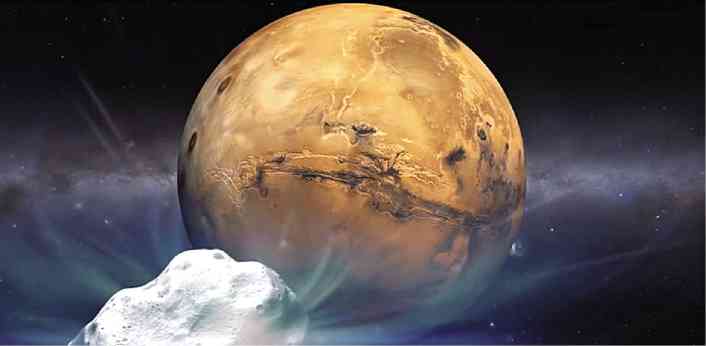Comet Siding Spring coming for 1st rousing visit in a million years

VISITOR FROM ANOTHER WORLD An artist’s concept depicts the comet Siding Spring and Mars. On Monday the comet will pass close to Mars and enable people to study it using binoculars. AFP/NASA
CAPE CANAVERAL, Florida—The heavens are hosting an event this weekend that occurs once in a million years or so.
A comet as hefty as a small mountain will pass mind-bogglingly close to Mars on Sunday (Monday in Manila), approaching within 140,006 kilometers at a speed of 202,767 kilometers per hour.
Nasa’s five robotic explorers at Mars—three orbiters and two rovers—are being repurposed to witness a comet named Siding Spring make its first known visit to the inner solar system. So are a European and an Indian spacecraft circling the red planet.
The orbiting craft will attempt to observe the incoming iceball, then hide behind Mars for protection from potentially dangerous dusty debris in the comet tail.
Shielded by the Martian atmosphere, the Opportunity and Curiosity rovers may well have the best seats in the house, although a dust storm on Mars could obscure the view.
“We certainly have fingers crossed for the first images of a comet from the surface of another world,” said Nasa program scientist Kelly Fast.
Spectacular view
Spacecraft farther afield, including the Hubble Space Telescope, already are keeping a sharp lookout, as are ground observatories and research balloons.
“We’re getting ready for a spectacular set of observations,” said Jim Green, head of Nasa’s planetary science division.

On Earth, the best viewing, via binoculars or telescope, will be from the southern hemisphere—South Africa and Australia will be in prime position. In the northern hemisphere, it will be difficult to see Siding Spring slide by Mars.
The comet—with a nucleus estimated to be at least 0.8 kilometer (half a mile) in diameter—hails from the Oort Cloud on the extreme fringe of the solar system.
It formed during the first million or two years of the solar system’s birth 4.6 billion years ago and, until now, ventured no closer to the sun than perhaps the orbits of Jupiter, Saturn, Uranus or Neptune.
It comes around every one or more million years.
It will be the first Oort Cloud comet to be studied up close in detail.
For comparison, the flyby distance of 140,006 kilometers is about one-third of the way from here to the moon. Siding Spring’s tail could extend from Earth all the way to our moon. Its gaseous coma, the fuzzy head surrounding the nucleus, might stretch halfway to the moon.
No comet has come anywhere near this close to Earth in recorded history.
“We can’t get to an Oort Cloud comet with our current rockets … so this comet is coming to us,” said Carey Lisse, senior astrophysicist at Johns Hopkins University’s applied physics laboratory.
By studying Siding Spring’s composition and structure, scientists hope to learn more about how the planets formed, according to Lisse.
Scientists also are keen to spot any changes to the comet or Mars due to the close approach. Nasa’s newly arrived Maven spacecraft, for instance, will compare the upper atmosphere before and after it passes.
“Think about a comet that started its travel probably at the dawn of man and it’s just coming in close now,” Lisse said. “And the reason we can actually observe it is because we have built satellites and rovers. We’ve now got outposts around Mars.”
Scientists initially worried the spacecraft orbiting Mars would be at considerable risk from the comet’s massive trail of dust.
The nucleus itself poses no danger of impact. But the particles in the tail, hurtling through space at 202,767 kph could fry electronics, puncture fuel lines, or destroy computers, transmitters or other vital spacecraft parts.
Duck and cover
As Siding Spring’s path became clearer, the threat level was deemed minimal. Still, space agencies are taking no chances. They’re employing the “duck and cover” strategy.
“Comets are complex beasts and don’t always live up to our predictions,” University of Maryland senior research scientist Tony Farnham said in an e-mail on Wednesday. “If you don’t want surprises, then don’t study comets.”
It will take at least a few days to obtain and analyze the best spacecraft data; but images made from Earth should be forthcoming pretty quickly.
Siding Spring should pass closest to the sun six days after its Mars flyby, then swing back out, bidding goodbye, for at least another million years.
RELATED STORIES
Filipino scientist helps make cooking on Mars possible